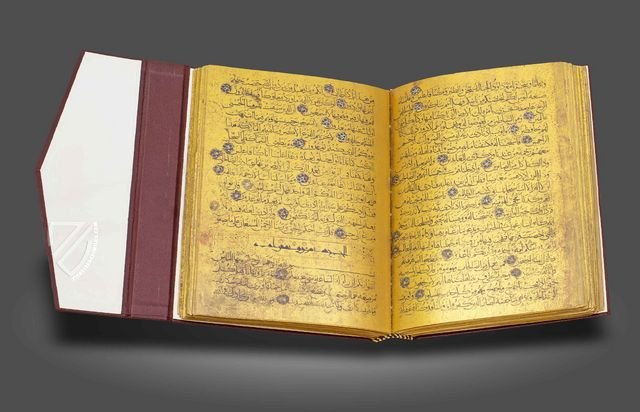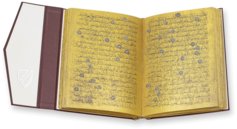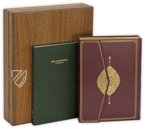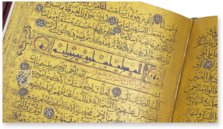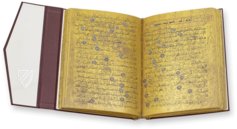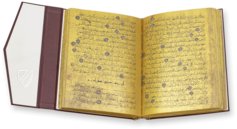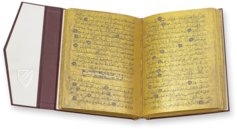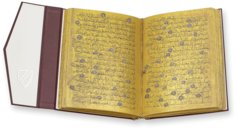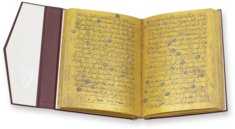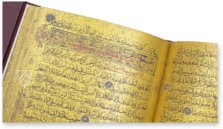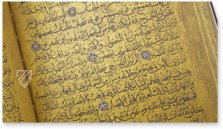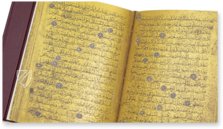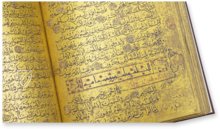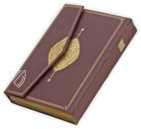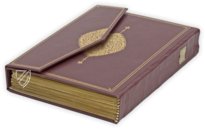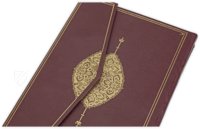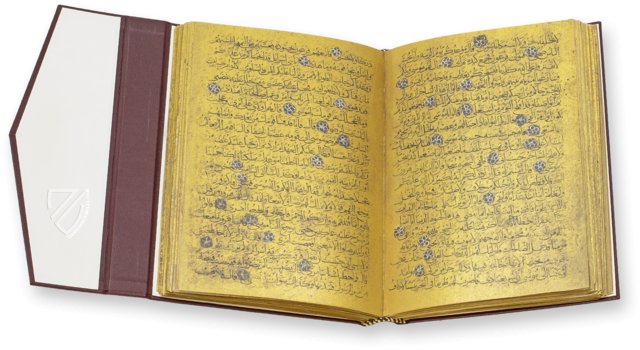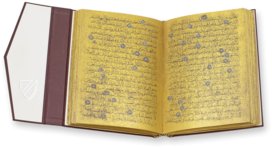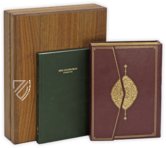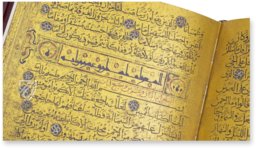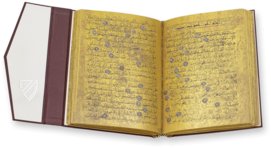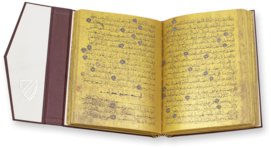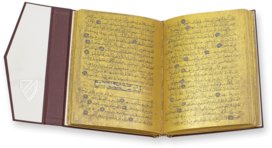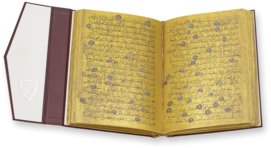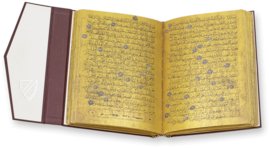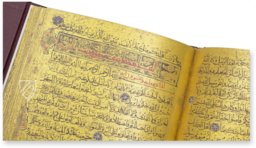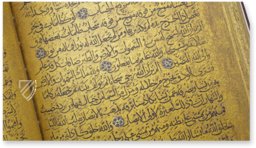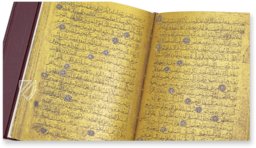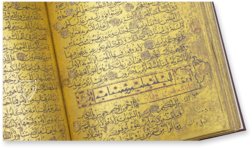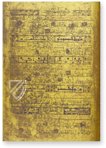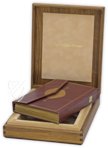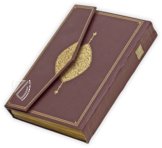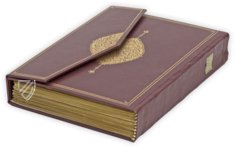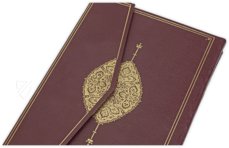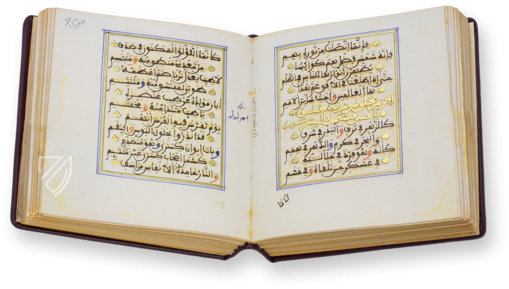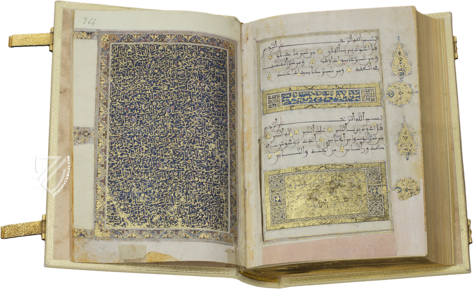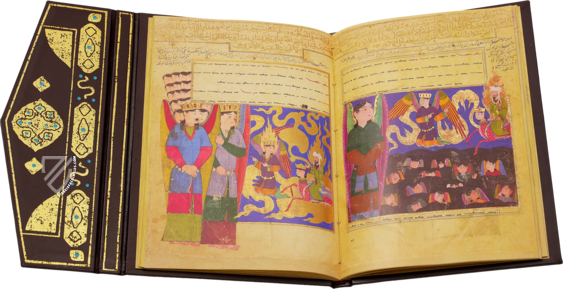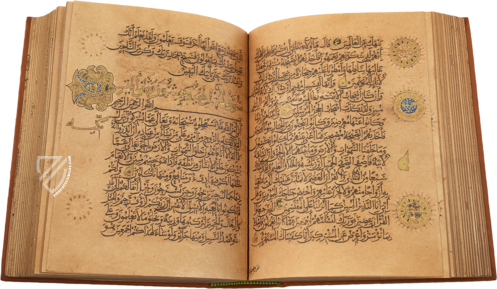Golden Koran
(3,000€ - 7,000€)
There are only a few copies of the Qur'an in existence that were produced on a colored writing surface, such as the Blue Qur'an by Kuli or copies of Qur'an pages colored with saffron or purple. The Qur'an presented here, however, is the only copy of its kind in the world: it was written on gold-coated paper in black Naskhi script. This script is based on mathematical calculations from the 10th century and is the reason why the characters appear so distinctively even. Its unit of measurement is the alif, the first letter of the Arabic alphabet. The script was used by two famous calligraphers in the 11th century. Among a number of other features of the Gold Qur'an, it enables its attribution to the renowned calligraphic school of Ibn al-Bawwab (d. 1022).
Golden Koran
So-called because every page of the manuscript is coated with powdered gold, the Golden Koran is an 11th century manuscript originating from Iran or Iraq. Its décor is not only expensive but, represents a unicum of manuscript art and is one of the most coveted Islamic manuscripts in existence. The elegant script of the manuscript was executed in a hand that was no less masterful than those responsible for the geometric patterns and other décor.
184 Shimmering Golden Leaves
Colored writing materials were used only rarely in Qur’an production: a famous exception is the Blue Qur’an in Kufic script, single leaves of which have been auctioned over hundreds of years. Some Qur’an manuscripts were dyed with saffron or crimson. The present Qur’an, which presumably originates from Iraq or Iran, has been written in black Naskhi script on paper and is a unique piece due to its gold-coated paper. Naskhi was standardized as a precisely proportioned cursive script by the calligrapher Ibn Muqla (died 940) in the 10th century. Its unit of scale is the alif, the first letter in the Arabic alphabet, upon which the size of all the other letters is based. The famous calligraphers Ibn al-Bawwab (died 1022) and Yakut Musta’simi (died 1298) also based their work on this mathematical principle.
High-Quality Islamic Art
The fragment of a decorative page at the start of the manuscript displays a geometric pattern consisting of octagons, stars, quatrefoils and script medallions. The Sura headings are framed in blue, white, and reddish brown with Kufic or a cursive script, and decorated with floral and arabesque patterns. The Basmala, which occurs at the start of all the Suras except for the ninth Sura, takes up either all or most of the first line. The title of the Sura is repeated with an indication of the verse number in red ink above the long, extended letter sin in the Basmala. The text is fully vocalized and the verses separated by rosettes. Some of the ornamental work around the edges has been lost because the book block was trimmed for a later binding.
Origins of the Manuscript
The Qur’an features a number of criteria which place it in the school of Ibn al-Bawwab: the unusual arrangement of the first page with two Sura titles, the elongated letter sin in the Basmala, the distribution of the Basmala across almost an entire line, the use of colors which Ibn al-Bawwab had just introduced such as white, brown and crimson red, and black ink, the slight leftward slant of the vertical letters, the dense and yet extremely clear style of writing are characteristic of this school. The quality of this unique codex on gilt paper, which was lavishly restored and hence saved over the course of a year in 1967 at the Institute of Book and Manuscript Restoration, part of the Bavarian State Library, would also correspond to the elevated status of the above-mentioned school of calligraphy.
Codicology
- Alternative Titles
- Goldkoran
- Type
- Manuscript on paper
- Size / Format
- 366 pages / 26.0 × 18.0 cm
- Origin
- Iran
- Date
- 11th century
- Style
- Language
- Illustrations
- Numerous decorations, such as blue and silver rosettes
- Artist / School
- Ibn al-Bawwab (d. 1022) (scribe)
Yakut Musta’simi (d. 1298) (scribe)
Golden Koran
Fragment of a Carpet Page
At the beginning of the manuscript, the fragment of a double-page illumination depicting an elaborate carpet has survived, which was typical of richly decorative Korans originating from central Iraq-Iran during the 11th or 12th centuries when the region was ruled by the Seljuk Turks. Surrounded by an interlace border, the carpet page in red, blue, and gold has a design consisting of floral décor suspended within geometric patterns consisting of circles with initials set within octagons connected to four-pointed compass stars set within quatrefoils.
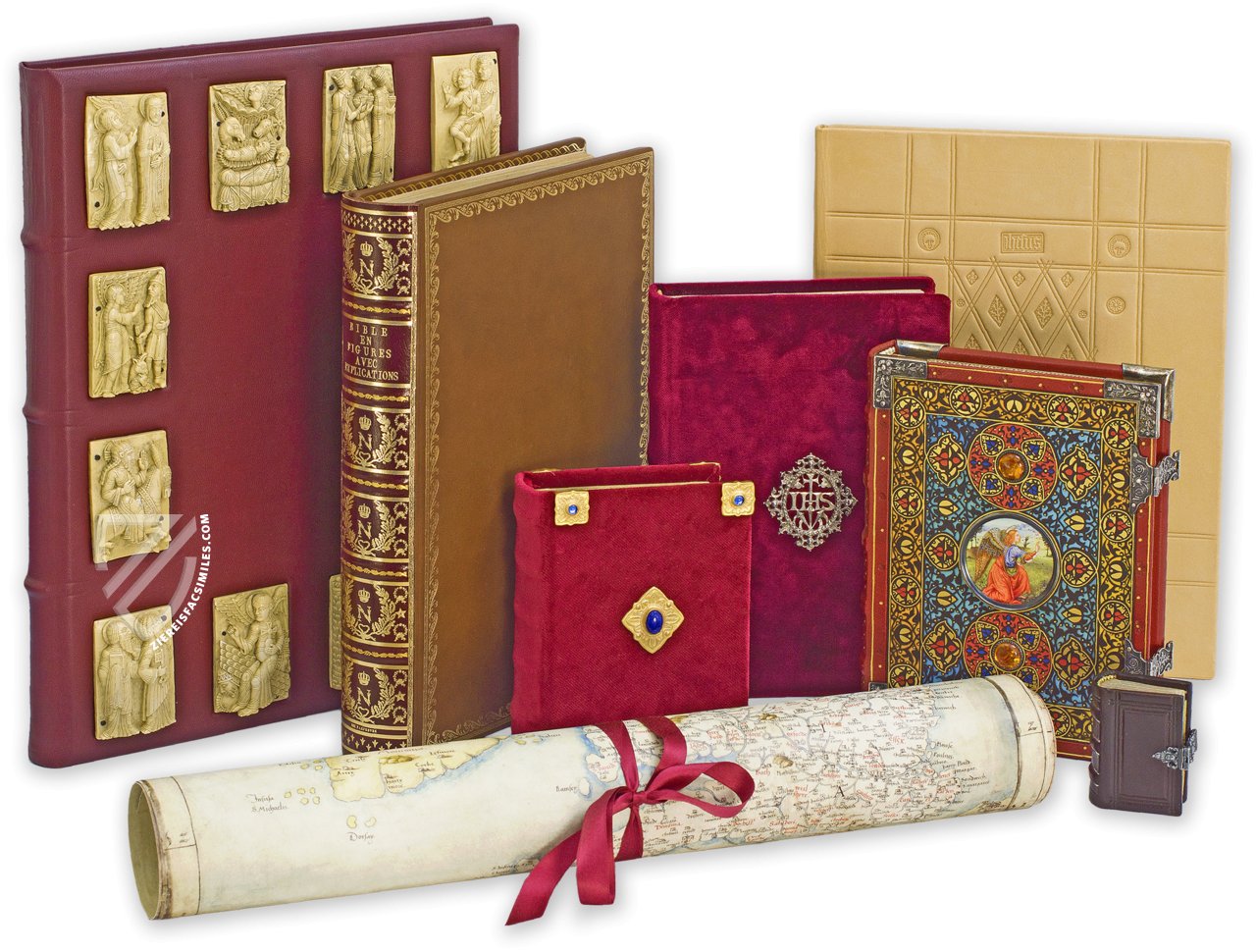
Golden Koran
Folio 44r
Manuscripts with colored backgrounds were as rare in the East as they were in the West and the gilt pages of this manuscript indicates its great importance. It is a masterpiece of calligraphy with a golden background that allows the Nashki script in black ink to really stand out. The chapter headings are written with Kufic script framed in blue, red, white, or black.
The text is fully vocalized and the verses are separated by blue and silver rosettes. Although the pages were trimmed in the 18th century, which resulted in the loss of some of the marginal ornamentation and about half of the palm-shaped “ansae” in the surah headings, the manuscript remains one of the most magnificent testimonials to the art of illuminated Islamic manuscripts.
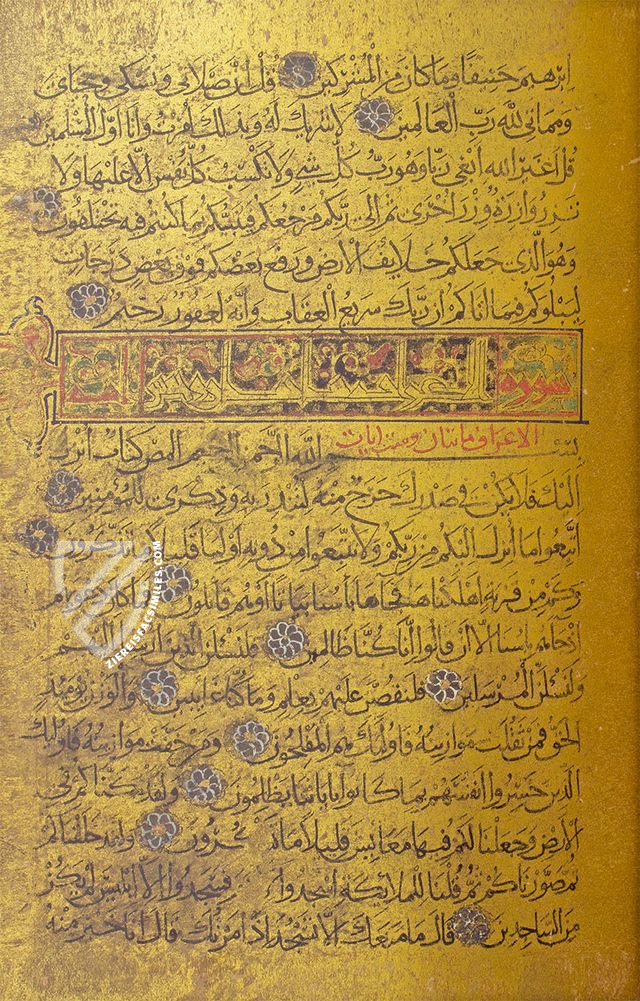
#1 Der Goldkoran
Language: German
(3,000€ - 7,000€)
- Treatises / Secular Books
- Apocalypses / Beatus
- Astronomy / Astrology
- Bestiaries
- Bibles / Gospels
- Chronicles / History / Law
- Geography / Maps
- Saints' Lives
- Islam / Oriental
- Judaism / Hebrew
- Single Leaf Collections
- Leonardo da Vinci
- Literature / Poetry
- Liturgical Manuscripts
- Medicine / Botany / Alchemy
- Music
- Mythology / Prophecies
- Psalters
- Other Religious Books
- Games / Hunting
- Private Devotion Books
- Other Genres
- Afghanistan
- Armenia
- Austria
- Belgium
- Belize
- Bosnia and Herzegovina
- China
- Colombia
- Costa Rica
- Croatia
- Cyprus
- Czech Republic
- Denmark
- Egypt
- El Salvador
- Ethiopia
- France
- Germany
- Greece
- Guatemala
- Honduras
- Hungary
- India
- Iran
- Iraq
- Israel
- Italy
- Japan
- Jordan
- Kazakhstan
- Kyrgyzstan
- Lebanon
- Liechtenstein
- Luxembourg
- Mexico
- Morocco
- Netherlands
- Palestine
- Panama
- Peru
- Poland
- Portugal
- Romania
- Russia
- Serbia
- Spain
- Sri Lanka
- Sweden
- Switzerland
- Syria
- Tajikistan
- Turkey
- Turkmenistan
- Ukraine
- United Kingdom
- United States
- Uzbekistan
- Vatican City
- A. Oosthoek, van Holkema & Warendorf
- Aboca Museum
- Ajuntament de Valencia
- Akademie Verlag
- Akademische Druck- u. Verlagsanstalt (ADEVA)
- Aldo Ausilio Editore - Bottega d’Erasmo
- Alecto Historical Editions
- Alkuin Verlag
- Almqvist & Wiksell
- Amilcare Pizzi
- Andreas & Andreas Verlagsbuchhandlung
- Archa 90
- Archiv Verlag
- Archivi Edizioni
- Arnold Verlag
- ARS
- Ars Magna
- ArtCodex
- AyN Ediciones
- Azimuth Editions
- Badenia Verlag
- Bärenreiter-Verlag
- Belser Verlag
- Belser Verlag / WK Wertkontor
- Benziger Verlag
- Bernardinum Wydawnictwo
- BiblioGemma
- Biblioteca Apostolica Vaticana (Vaticanstadt, Vaticanstadt)
- Bibliotheca Palatina Faksimile Verlag
- Bibliotheca Rara
- Boydell & Brewer
- Bramante Edizioni
- Bredius Genootschap
- Brepols Publishers
- British Library
- C. Weckesser
- Caixa Catalunya
- Canesi
- CAPSA, Ars Scriptoria
- Caratzas Brothers, Publishers
- Carus Verlag
- Casamassima Libri
- Centrum Cartographie Verlag GmbH
- Chavane Verlag
- Christian Brandstätter Verlag
- Circulo Cientifico
- Club Bibliófilo Versol
- Club du Livre
- CM Editores
- Collegium Graphicum
- Collezione Apocrifa Da Vinci
- Comissão Nacional para as Comemorações dos Descobrimentos Portugueses
- Coron Verlag
- Corvina
- CTHS
- D. S. Brewer
- Damon
- De Agostini/UTET
- De Nederlandsche Boekhandel
- De Schutter
- Deuschle & Stemmle
- Deutscher Verlag für Kunstwissenschaft
- DIAMM
- Droz
- E. Schreiber Graphische Kunstanstalten
- Ediciones Boreal
- Ediciones Grial
- Ediclube
- Edições Inapa
- Edilan
- Editalia
- Edition Deuschle
- Edition Georg Popp
- Edition Leipzig
- Edition Libri Illustri
- Editiones Reales Sitios S. L.
- Éditions de l'Oiseau Lyre
- Editions Medicina Rara
- Editorial Casariego
- Editorial Mintzoa
- Editrice Antenore
- Editrice Velar
- Edizioni Edison
- Egeria, S.L.
- Eikon Editores
- Electa
- Emery Walker Limited
- Enciclopèdia Catalana
- Eos-Verlag
- Ephesus Publishing
- Ernst Battenberg
- Eugrammia Press
- Extraordinary Editions
- Fackelverlag
- Facsimila Art & Edition
- Facsimile Editions Ltd.
- Facsimilia Art & Edition Ebert KG
- Faksimile Verlag
- Feuermann Verlag
- Folger Shakespeare Library
- Franco Cosimo Panini Editore
- Friedrich Wittig Verlag
- Fundación Hullera Vasco-Leonesa
- G. Braziller
- Gabriele Mazzotta Editore
- Gebr. Mann Verlag
- Gesellschaft für graphische Industrie
- Getty Research Institute
- Giovanni Domenico de Rossi
- Giunti Editore
- Graffiti
- Grafica European Center of Fine Arts
- Guido Pressler
- Guillermo Blazquez
- Gustav Kiepenheuer
- H. N. Abrams
- Harrassowitz
- Harvard University Press
- Helikon
- Hendrickson Publishers
- Henning Oppermann
- Herder Verlag
- Hes & De Graaf Publishers
- Hoepli
- Holbein-Verlag
- Houghton Library
- Hugo Schmidt Verlag
- Idion Verlag
- Il Bulino, edizioni d'arte
- ILte
- Imago
- Insel Verlag
- Insel-Verlag Anton Kippenberger
- Instituto de Estudios Altoaragoneses
- Instituto Nacional de Antropología e Historia
- Introligatornia Budnik Jerzy
- Istituto dell'Enciclopedia Italiana - Treccani
- Istituto Ellenico di Studi Bizantini e Postbizantini
- Istituto Geografico De Agostini
- Istituto Poligrafico e Zecca dello Stato
- Italarte Art Establishments
- Jan Thorbecke Verlag
- Johnson Reprint Corporation
- Josef Stocker
- Josef Stocker-Schmid
- Jugoslavija
- Karl W. Hiersemann
- Kasper Straube
- Kaydeda Ediciones
- Kindler Verlag / Coron Verlag
- Kodansha International Ltd.
- Konrad Kölbl Verlag
- Kurt Wolff Verlag
- La Liberia dello Stato
- La Linea Editrice
- La Meta Editore
- Lambert Schneider
- Landeskreditbank Baden-Württemberg
- Leo S. Olschki
- Les Incunables
- Liber Artis
- Library of Congress
- Libreria Musicale Italiana
- Lichtdruck
- Lito Immagine Editore
- Lumen Artis
- Lund Humphries
- M. Moleiro Editor
- Maison des Sciences de l'homme et de la société de Poitiers
- Manuscriptum
- Martinus Nijhoff
- Maruzen-Yushodo Co. Ltd.
- MASA
- Massada Publishers
- McGraw-Hill
- Metropolitan Museum of Art
- Militos
- Millennium Liber
- Müller & Schindler
- Nahar - Stavit
- Nahar and Steimatzky
- National Library of Wales
- Neri Pozza
- Nova Charta
- Oceanum Verlag
- Odeon
- Orbis Mediaevalis
- Orbis Pictus
- Österreichische Staatsdruckerei
- Oxford University Press
- Pageant Books
- Parzellers Buchverlag
- Patrimonio Ediciones
- Pattloch Verlag
- PIAF
- Pieper Verlag
- Plon-Nourrit et cie
- Poligrafiche Bolis
- Presses Universitaires de Strasbourg
- Prestel Verlag
- Princeton University Press
- Prisma Verlag
- Priuli & Verlucca, editori
- Pro Sport Verlag
- Propyläen Verlag
- Pytheas Books
- Quaternio Verlag Luzern
- Reales Sitios
- Recht-Verlag
- Reichert Verlag
- Reichsdruckerei
- Reprint Verlag
- Riehn & Reusch
- Roberto Vattori Editore
- Rosenkilde and Bagger
- Roxburghe Club
- Salerno Editrice
- Saltellus Press
- Sandoz
- Sarajevo Svjetlost
- Schöck ArtPrint Kft.
- Schulsinger Brothers
- Scolar Press
- Scrinium
- Scripta Maneant
- Scriptorium
- Shazar
- Siloé, arte y bibliofilia
- SISMEL - Edizioni del Galluzzo
- Sociedad Mexicana de Antropología
- Société des Bibliophiles & Iconophiles de Belgique
- Soncin Publishing
- Sorli Ediciones
- Stainer and Bell
- Studer
- Styria Verlag
- Sumptibus Pragopress
- Szegedi Tudomànyegyetem
- Taberna Libraria
- Tarshish Books
- Taschen
- Tempus Libri
- Testimonio Compañía Editorial
- Thames and Hudson
- The Clear Vue Publishing Partnership Limited
- The Facsimile Codex
- The Folio Society
- The Marquess of Normanby
- The Richard III and Yorkist History Trust
- Tip.Le.Co
- TouchArt
- TREC Publishing House
- TRI Publishing Co.
- Trident Editore
- Tuliba Collection
- Typis Regiae Officinae Polygraphicae
- Union Verlag Berlin
- Universidad de Granada
- University of California Press
- University of Chicago Press
- Urs Graf
- Vallecchi
- Van Wijnen
- VCH, Acta Humaniora
- VDI Verlag
- VEB Deutscher Verlag für Musik
- Verlag Anton Pustet / Andreas Verlag
- Verlag Bibliophile Drucke Josef Stocker
- Verlag der Münchner Drucke
- Verlag für Regionalgeschichte
- Verlag Styria
- Vicent Garcia Editores
- W. Turnowski Ltd.
- W. Turnowsky
- Waanders Printers
- Wiener Mechitharisten-Congregation (Wien, Österreich)
- Wissenschaftliche Buchgesellschaft
- Wissenschaftliche Verlagsgesellschaft
- Wydawnictwo Dolnoslaskie
- Xuntanza Editorial
- Zakład Narodowy
- Zollikofer AG

